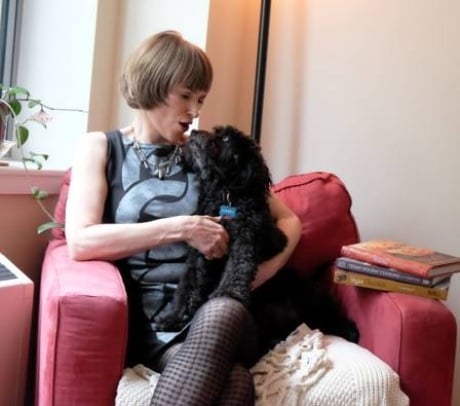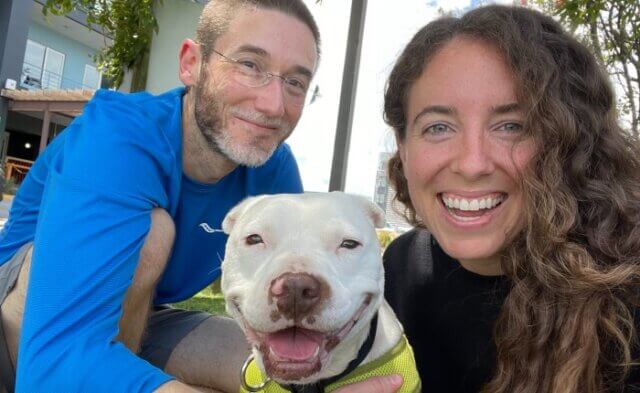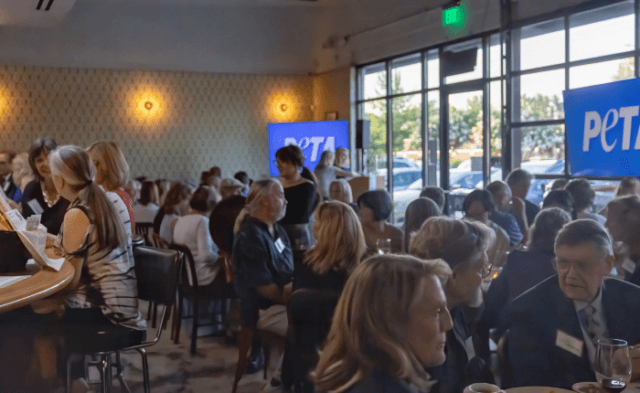
Can you talk a bit about the concept behind Main Street Vegan?
Main Street Vegan has its roots in a PETA fundraiser in New York City a few years back, where I saw video clips about animal abuse. These were the same kinds of clips I’d been seeing for ages, but that night my heart was open a bit extra. All I wanted with every fiber of my being was to help the animals more than I ever had.
That night, going home in the subway, the inspiration came for Main Street Vegan. It was so clear, almost dictated: Your next book is supposed to be Main Street Vegan. It needs to have 40 short chapters with a recipe after each one. It has to cover every aspect of vegan living, and you need to gear it to the new vegan you once were. The next morning, I told my literary agent that I knew what my next book would be.
What is your advice for people on a tight budget who want to go (or stay) vegan?
The way to be a frugal vegan is, I think, to eat more like an old-days vegan, choosing basic foods—vegetables, fruits, legumes, whole grains, and some nuts and seeds—more than the pricier processed foods. (That’s a healthy idea, too.) Buying in season, buying in bulk, joining a food co-op or signing on for a Community Supported Agriculture share, can also save you quite a bit.
Another thing to look at is how much you’re saving when you let go of animal foods, both on your grocery tab and on future medical bills. The standard American diet is killing people, and nobody should be eating it. Over time, your improved health will more than pay for any extra you spend on groceries. Even more importantly, you can’t put a price tag on the value of saving innocent lives.
You’ve been vegan for over 30 years. What were some of the changes you noticed in your health after you took meat, eggs, and dairy products off the menu?
When I became a vegetarian, I was just 19 and my health problems had been largely confined to being overweight and getting frequent colds. When I went vegetarian, I actually got fatter. I threw caution to the wind and returned to my former pattern of binge eating. But once I learned that my eating situation was an addiction and that I needed recovery, just like any addict, a wonderful thing happened: I had the power of choice around food, something I’d lost early on. Once I was able to choose, I chose vegan.
That was when I noticed a difference in my health. The weight fell off without anything resembling a diet, although I do eat healthy and I usually eat only at mealtimes. Having kept off the weight—some 60 pounds—for three decades is pretty amazing. Another plus was that after going vegan, I went 12 full months without a cold or sinus infection. This was a record for me.
What was a challenge you faced as a new vegan, and how did you overcome it?
I travel a lot in my work as an author and speaker, and eating on the road, in the air, and in unfamiliar towns and cities was my biggest challenge then—and, frankly, it’s the biggest challenge now.
I’ve scoped out veg offerings at the airports with which I’m most familiar, and I know that I can count on Starbucks for soy milk and sometimes a brown rice and kale salad. There’s usually an Asian place with a vegetable dish or two in the food court and some really excellent salad spots. Even so, I often pack a salad with oomph factor (beans, sunflower or pumpkin seeds, steamed yams) for a flight. And I usually carry some nuts and dark chocolate with me. I’ve been stranded at small airports enough times to recognize the need for reinforcements.
At home—and elsewhere when I can get to a veg-friendly restaurant or a grocery store—I eat a high raw diet and try to make choices that are as healthy as can be. On the road, all bets—except for not harming animals—are off. This is where I’ll have my twice-a-year order of fries or a veggie sandwich on a white baguette. I figure I could stay home all the time and eat really well or get out and be part of the larger world and once in a while eat some white bread. It’s not perfect, but it works.
Victoria with adorable rescued dog Forbes. Photo credit: Chris Pearce & La Fashionista Compassionista magazine
Your upcoming book, The Good Karma Diet, has as its subtitle Eat Gently, Feel Amazing, Age in Slow Motion. Can you talk a bit about how what we eat affects our aging process?
There’s more and more evidence that although aging is inevitable, falling apart is largely optional. There’s actually a new science called epigenetics devoted to the concept that diet and lifestyle may be able to change our very DNA—pretty revolutionary stuff. Diet isn’t the only factor. Regular meditation slows the aging process. One study showed that people who meditated twice daily for five years or more were 12 years younger [physically] than non-meditators. Exercise is also key: At the cellular level, it’s movement that tells your body that you’re still in the game, still worth taking care of. Inactivity, on the other hand, suggests winter and famine and calling it quits—not the message you want to send. In addition, you don’t want to poison yourself, so if you smoke, stop and, as much as you possibly can, avoid toxic chemicals in your foods, on your skin, and under your kitchen sink.
When it comes to food, the best thing you can do for yourself is eat plants and plenty of them. Nature made sure to infuse fruits, vegetables, beans, tea, spices, and other plant foods with phytochemicals. They’re there to protect the plant, but when we eat those foods, the protection passes on to us. These substances are powerful enough to gobble up cancer cells (mushrooms are terrific at doing that) and guarding your brain against dementia (blueberries shine in that department).
In my decades of observation, it seems to me that vegans age better than other people and high raw vegans, i.e., those people who eat a lot of their foods uncooked and unprocessed—salads, smoothies, fresh green juices, sprouts, and the like—defy the negative aspects of aging best of all. It makes sense: All of us, as vegans, are keeping death off our plates, and when we eat fresh, raw foods, we’re infusing our bodies with life. It’s the life-force energy the yogis call prana and Chinese medicine refers to as ch’i. You can’t measure it in a lab test, but you can see it in the bright eyes, clear skin, and youthful attitude of people who eat this way, even when they reach advanced age.
What advice would you give PETA Prime readers who are thinking about going vegan for the first time in their 50s, 60s, 70s, or beyond?
Audrey Hepburn said famously that there’s no bad time to visit Paris. Similarly, there’s no bad time to go vegan. While your body may have had many years of animal foods, it’s actually a physiological relief when you stop eating them. Humans have adapted to consuming animals and animal products, but we haven’t adapted very well, or heart disease wouldn’t be the number one killer of women and men throughout the Western world. Give yourself—your heart, your arteries, your circulatory system—a break and celebrate that you’re saving lives simply by choosing one item instead of another from the grocery shelf or restaurant menu.
We hear a lot these days about cravings and that if you go vegan and then crave fish or eggs or something else, you must be missing some nutrient these dead animals or their bodily secretions contain. But that’s not it. I say in The Good Karma Diet that cravings are vestiges of lost loves. Those foods are familiar, and you’re likely to miss some of those flavors and textures. This is where the faux meats, nondairy milks, vegan cheeses, and so forth come in.
Occasionally, a longtime vegan will say, “Why do you need something that wants to mimic flesh?” Well, because you ate it since you stopped drinking infant formula and you developed a taste for it. Faux meats were actually developed by Chinese Buddhist monks who were dedicated to the principle of ahimsa, non-killing and harmlessness, but who missed the foods they’d grown up on. Why do we think we need to be more austere than a monk? If you want a burger, have a burger (veggie, of course). If you want a pizza, make it with Daiya cheese. Include all those health-promoting leafy greens and beans and berries, too, but whatever “processed” vegan foods will help you stay with this can play an important role, too.
Finally, at any age, I like to see people get off the meat wagon the same way recovering alcoholics stay sober in AA: a day at a time. This is the day to be vegan—not sometime next week after you’ve been to Whole Foods or in January when you’re making resolutions, just today. It’s sweetly stunning how “today” becomes forever and you just don’t have to think about it much anymore.
You’re a PETA Business Friend. Can you tell us a little about this program and how PETA Prime readers who own businesses can get involved?
I’m really proud to be part of PETA Business Friends and grateful for the support and networking provided by the program. You see, I’ve always thought of myself as an artist: I write books. I speak, which is one step removed from performing. I host the Main Street Vegan podcast—performing again. So for most of my life, I thought “business” was for somebody else. But after Main Street Vegan was published in 2012, I was inspired to form Main Street Vegan Academy, a six-day, in-person intensive in New York City that trains and certifies Vegan Lifestyle Coaches and Educators. We have an incredible faculty, and we take fabulous field trips to many of the city’s vegan shops and restaurants, and people from nine countries so far have attended and been thoroughly pleased with the course. For me, it’s a labor of love—but it’s still a business, not something I studied in school or have a particular affinity for. Enter PETA Business Friends.
This program gives me, first, peers—other compassionate business owners who share the vision of a cruelty-free world and who share the marketplace realities all entrepreneurs face. And PETA Business Friends gives Main Street Vegan Academy exposure to the very people it’s looking to target: committed vegans who want to go a step further. If you’re looking to reach this market, where better than PETA to go to do it? And finally, being a member of PETA Business Friends is a special reminder to me to hire, consult with, and purchase from other companies and individuals who are serious about changing the world for animals. It’s good to put my money where it does no harm—putting it where is does great good is that much better.
Photo of Victoria in Union Jack dress from vegan designer LoisEastlund.com & hat by VauteCouture.com. Credit: Chris Pearce & La Fashionista Compassionista magazine.





